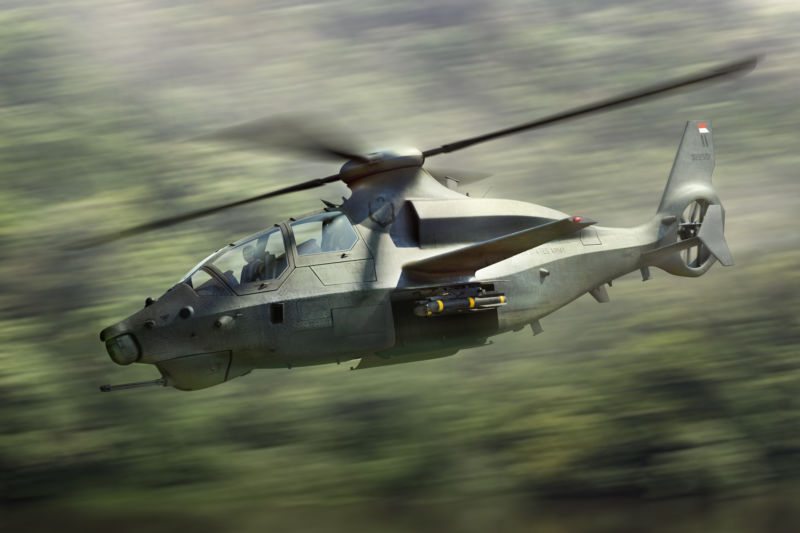
Bell-Textron
Bell Textron has unveiled the design for the company’s entrant into the US Army’s Future Attack Reconnaissance Aircraft (FARA) program: a single-rotor helicopter called the Bell 360 Invictus. The shark-like design, which uses rotor technology developed for the Bell 525 Relentless medium-lift helicopter, will be “optionally manned” capable—meaning it can either carry a crew of two or fly autonomously.
The Army is looking for a “knife fighter” for the FARA role—a high-speed, agile, and lightly armed helicopter capable of defending itself while probing enemy positions—rather than a heavy attack helicopter. A winning FARA design will have to be able to maneuver in urban environments, fly at speeds above 200mph (322km/h), and fly without pilots to perform intelligence and reconnaissance missions.
The Army retired its last dedicated scout helicopter, the Bell OH-58 Kiowa, in 2017; since then, the Army’s armed reconnaissance squadrons have flown the Boeing AH-64 Apache instead. But the Army is looking to retire about half of the Apache fleet with whichever aircraft wins the FARA competition, beginning in 2028.
Bell’s competitors in the FARA design competition include Lockheed’s Sikorsky unit and Boeing (which teamed on a design for the Army’s other major new aircraft effort, the Future Long Range Assault Aircraft program). Airbus has also indicated that it has submitted a design for the competition.
Sikorsky would appear to have a fairly long lead in terms of initial execution on its design—the S-97 Raider, a helicopter with advanced coaxial rigid rotors and a single pusher rotor, capable of an airspeed of 280mph (440km/h or 240 knots), was developed with the scouting mission in mind and first flew in 2015. But Boeing is reportedly looking at a high-speed design derived from the Apache AH-64E Guardian. And Airbus has proposed a design based on its Eurocopter X3 experimental high-speed hybrid helicopter with two outboard pusher rotors.
The Bell design is less radical than Sikorsky’s and Airbus’ designs on the surface, but Bell claims that the aircraft will have similar performance capabilities. The 525 Relentless rotor system has been able to achieve speeds “above 200 Knots True Air Speed (KTAS)” (230mph, 370 km/h). And the Invictus design includes lift-sharing wings to reduce the lift requirements on rotors during high-speed forward flight—intended to help reduce the retreating blade stall effect experienced by conventional helicopters at high speed.
The Bell design also includes a 20mm cannon in the nose and integrated “munitions launchers” on each side, capable of carrying Hellfire missiles and other current and future air-launched weapons. It also will carry “enhanced situational awareness and sensor technologies,” according to a Bell press statement. It will incorporate a “Digital Backbone” created by Collins Aerospace to accommodate the Defense Department’s desire for a “Modular Open Systems Approach” to avionics and systems—an engineering mandate to make rapid upgrades possible and lower later acquisition costs.